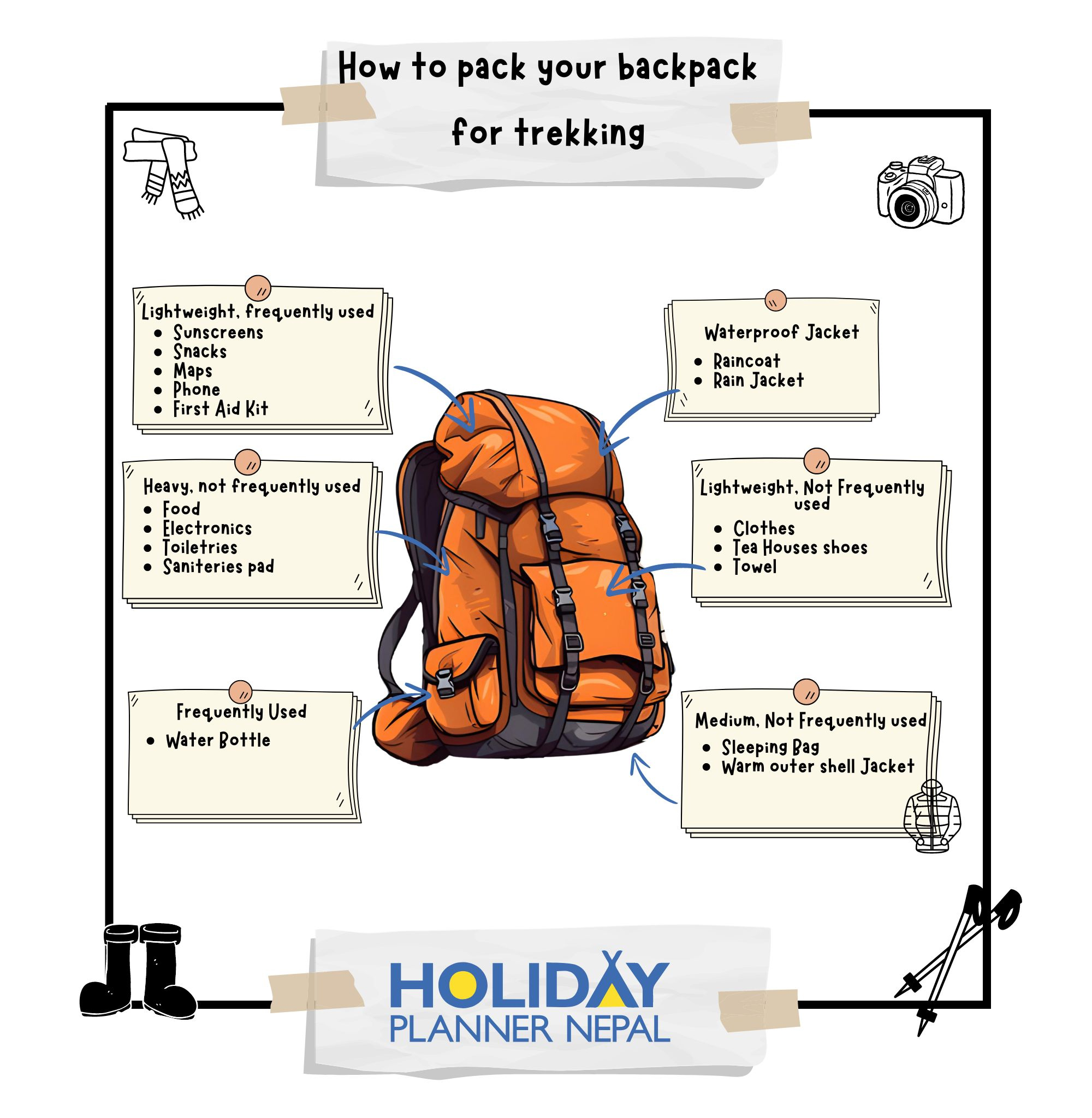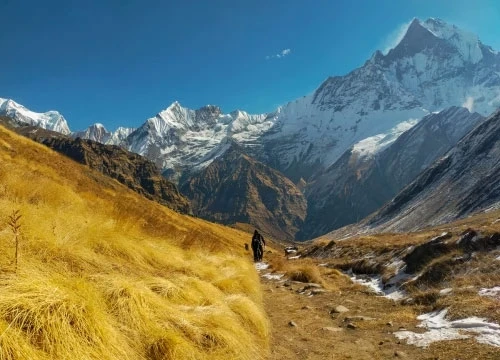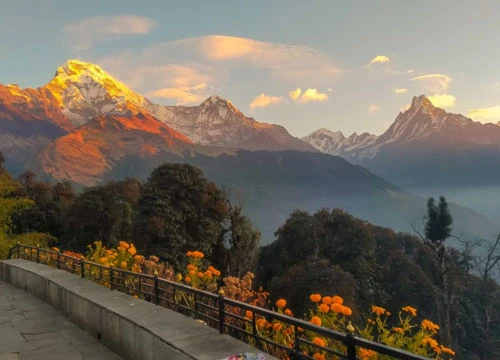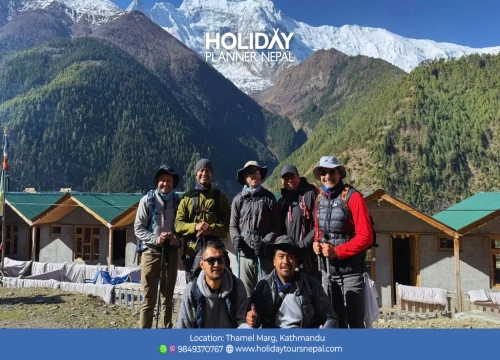About Ghandruk Trekking
The Ghandruk Trek is part of the famous Ghorepani Poon Hill Trek, taking you through lush rhododendron forests, terraced farmlands, and picturesque villages. The trek begins with a scenic drive from Pokhara to Nayapul (approximately 1 hour), followed by a short walk to Birethanti. The trail follows the Bhurungdi River, passing through beautiful landscapes and welcoming local communities.
As you ascend, you’ll be rewarded with stunning views of Annapurna South (7,219 m), Machhapuchhre (Fishtail, 6,993 m), Hiunchuli, Gangapurna, and Dhaulagiri (8,167 m). The trek is relatively easy and can be completed within 3 days, making it ideal for families, couples, and first-time trekkers.
The perfect trek choice for those seeking a condensed but fulfilling adventure in the amazing Annapurna Region of Nepal. The exciting trek of the 3-day Ghandruk Village Trek! Get ready to embark on a journey filled with amazing landscapes, cultural encounters, and unforgettable experiences.
- This trek offers you to witness magnificent views of the Annapurna South (7,219 meters / 23,684 feet.),Machapuchare (Fishtail) (6,993 meters / 22,943 feet),Hiunchuli (6,441 meters / 21,131 feet), Annapurna III (7,555 meters / 24,787 feet), and Gangapurna (7,454 meters / 24,455 feet)
- Ghandruk village is itself the major highlight of the Ghandruk Village trekking. This village is a picturesque Gurung settlement tucked away in the Himalayas.
- Trek to Ghandruk village provides a glimpse of traditional village life and culture in Nepal. You can visit the Gurung Museum, and engage in pleasant interactions with the locals.
- The trekking to Ghandruk village helps you to interact with the Gurung people and learn their distinctive customs, traditions, and way of life.
- Trekking to Ghandruk Village takes you through lush rhododendron forests, which are especially beautiful when the flowers are in full bloom in the spring. The forested trails add to the natural beauty of the trek.
- This 3-day trek is a quick adventure for people who don't have much time, so a wide range of walkers can do it.
Advantages of booking Ghandruk trek with Holiday Tours Nepal
- Private vehicles pick up and drop off to clients at all airports.
- First-aid kit box.
- Holiday Tours Nepal t-shirts, maps, caps, are provided. Down jackets and sleeping bags are rented if necessary.
- Arrangement of emergency evacuation service (you should have insurance for emergency evacuation, which will be paid for by your travel insurance company).
- We use an oximeter to check your pulse, oxygen saturation, and heart rate, every evening to trek and provide oxygen in case needed.
- Sim cards are provided by our company for travelers, so there won’t be any networking issues.
Some Key Points of Ghandruk Short Trek
Trek Duration: 3 Days
Maximum Elevation: Ghandruk – 1,970 m / 6,464 ft
Starting Point: Phedi (after 30-minute drive from Pokhara)
Ending Point: Nayapul, then drive back to Pokhara
Trek Difficulty: Easy – suitable for beginners and families
Best Seasons: Spring (March–May) and Autumn (September–November)
Cultural Experience: Gurung villages of Tolka and Ghandruk
Scenic Views: Annapurna South, Hiunchuli, and Machhapuchhre (Fishtail)
Ghandruk Trekking: 3 Days Altitude and Distance Coverage
Day | Activity | Altitude (m/ft) | Distance (km/miles) | Duration (hours) | Elevation Gain/Loss |
01 | Drive to Phedi, trek to Tolka | 1,810 m / 5,938 ft | ~10 km / 6.2 miles (trek) | ~4-5 hrs (trek) | +1,050 m / +3,445 ft |
02 | Trek to Ghandruk | 1,970 m / 6,464 ft | ~10 km / 6.2 miles (trek) | ~4-5 hrs (trek) | +160 m / +528 ft |
03 | Trek to Nayapul, drive back to Pokhara | 860 m / 2,822 ft (Nayapul), 860 m / 2,822 ft (Pokhara) | ~10 km / 6.2 miles (trek) + 40 km / 25 miles (drive) | ~4-5 hrs (trek) + 2 hrs (drive) | -1,110 m / -3,642 ft (trek), 0 m / 0 ft (drive) |
What is the specialty of Ghandruk village?
Ghandruk village is a satisfying and enlightening experience for a number of reasons:
- From Ghandruk Village, we can see the Annapurna and Machapuchare (Fishtail) Mountain Range from a wide angle. Especially at sunrise and sunset, these tall peaks make a beautiful background for your hike.
- Ghandruk is a traditional Gurung town, and the trek is a great way to learn more about the local culture. You can talk to Gurung people, find out about their traditions, go to the Gurung Museum, and see traditional dances and ceremonies.
- The hike takes you through lush rhododendron woods, terraced fields, and other beautiful natural areas. Depending on the time of year, the trail may have beautiful rhododendron buds that add to its natural beauty.
- Teahouses are places to stay, and the hotels along the way offer comfortable rooms and real Nepali food. It's a chance to take a break, get to know the locals, and meet other hikers.
- Ghandruk isn't too hard to get to from Pokhara, which is one of Nepal's most popular tourist cities. This makes it a good choice for people who want a faster journey.
- Trekking to Ghandruk is a good way for tourists and locals to learn about each other's cultures. Your visit helps the local economy, and talking to the people helps you learn more about the area's history.
- Most of the time, the walk starts and ends with a beautiful drive from Pokhara to Nayapul and back. These drives give you a chance to see the beautiful landscapes of Nepal.
- Ghandruk trip usually takes between 3 and 4 days, so it's great for people who don't have much time or who want a shorter trip. You can do it over a long weekend or as a side trip while you are in Nepal.
- There are many great places to take pictures on the trek, such as mountain views, traditional towns, and colorful landscapes. It's a wildlife and landscape photographer's dream come true.
- The trip gives you a chance to try new things and get some exercise, but it also gives you time to relax and enjoy nature. It's a chance to get away from the busyness of everyday life and get back in touch with nature.
Overall, trekking to Ghandruk Village combines natural beauty, cultural richness, and a sense of adventure, making it a memorable and satisfying experience for trekkers from different backgrounds and with different interests. Ghandruk Village Trek has something special for everyone, whether you've been trekking before or this is your first time in Nepal.
How to prepare for Ghandruk Village Trek?
Holiday Planner Nepal always suggests certain measures to follow for the preparation of any trek in Nepal. Even for the Ghandruk trek there are certain measures to follow to stay safe and have a good time. Here are some important steps and things to think about to help you get ready:
- Ghandruk goes through hilly areas, and some parts can be quite steep. Starting a daily fitness routine, including cardio, strength training, and endurance exercises, at least a few months before your trek is crucial for optimal health.
- Trekkers can even consider going on hikes or walks near your home to prepare for trekking and build your fitness.
- Always go with the proper hiking gear for trekking, like sturdy and comfortable hiking boots, clothes that wick away wetness, insulated layers, a rain jacket, a good-quality backpack, and a sleeping bag that is right for the time of year you plan to trek.
- Don't forget things like a sun hat, sunglasses, gloves, a headlamp or flashlight with extra batteries, and a hat to protect your face from the heat.
- Get the TIMS (Trekkers' Information Management System) card and the ACAP (Annapurna Conservation Area Permit) These are needed to enter the Annapurna Conservation Area.
- Trekkers can get an all-inclusive trip insurance that includes medical evacuation and covers trekking. Make sure your insurance covers you at the altitude you will be hiking.
- New government rules mandate the use of either a guide or porter for trekking in Nepal, prioritizing safety as a primary measure.
- Talk to your doctor or a travel center to make sure you have all the shots and medicines you need for Nepal. Talk about how to avoid mountain sickness and other health issues.
- For your trek to Ghandruk Village, better to take Nepali rupees as there may be limited cash on ATM at Ghandruk.
- On the trail, the exchange rate may be less so, exchange money in the city before embarking on the trek.
- Check the weather for the time of year you want to go trekking. Dress in layers and be ready for changing temperatures, especially at higher levels.
- Learn about the local customs and societal norms and try to follow them. Dress modestly and ask permission before taking pictures of people or their stuff.
- Follow the Leave No Trace principles to make the least amount of damage to the earth. Throw away trash the right way and don't use single-use plastics.
- On the trail, you must need to stay hydrated by drinking a lot of water, and keep your energy up by eating healthy foods.
Best Season and time for Ghandruk Trekking?
Ghandruk trek can be done at any time of the year. Still, the best season or time to go on a Ghandruk Trek is during the fall and spring. These months the weather offers pleasant temperatures, clear skies, and most nice during the months, making it a great time to go hiking. In Ghandruk, the best times to go hiking are during these two main seasons:
Autumn (September to November)
The autumn season is one of the peak seasons to trek in Nepal. It is always recommended that you take the Ghandruk Trek in autumn. This time of year is great for hiking since the weather is predictable, the skies are clear, and the temperature is moderate. The trek in the cool and pleasant air of fall, the mountains, notably Annapurna and Machapuchre, appear to look their best. The hiking conditions are usually pleasant, and the paths have been well-maintained.
Season of spring (March-May)
The spring season is also one of the finest seasons to trek in Nepal. The Ghandruk Trek is second-best in the spring. Temperatures are high and gradually decrease as you gain elevation. In the spring, the rhododendron groves that line the path burst into bloom, transforming the surrounding environment into a riot of color. The best time to go bird-watching in the area is at this time of year.
The beautiful skies of spring and autumn make it more probable that you will see the Himalayas in all their glory. While daytime temperatures are ideal for hiking, nights, especially at higher elevations, can be quite frigid. These times of year are also peak trekking and tourist seasons, so you can expect lively conversation in the trailside teahouses and the company of like-minded adventurers.
Although the Ghandruk Trek is at its best in the fall and spring, it can be done at any time of year. However, there are other factors to think about during different seasons:
Winter (December - February) is a good time to go trekking in Ghandruk, though temperatures may be much lower and certain teahouses at higher elevations may be closed. At higher altitudes, trails may also be covered with snow or ice.
During the monsoon season (June–August), the region receives significant precipitation, making hiking more difficult due to muddy pathways, leeches, and poor visibility. Some hiking trails may be closed if landslides occur. Those planning a trek in the Annapurna Region should avoid doing this.
In general, the Ghandruk Trek is most enjoyable and safe during the fall or spring, but you should double-check the weather and trail conditions before setting out on your adventure.
Local culture and tradition around Ghandruk village
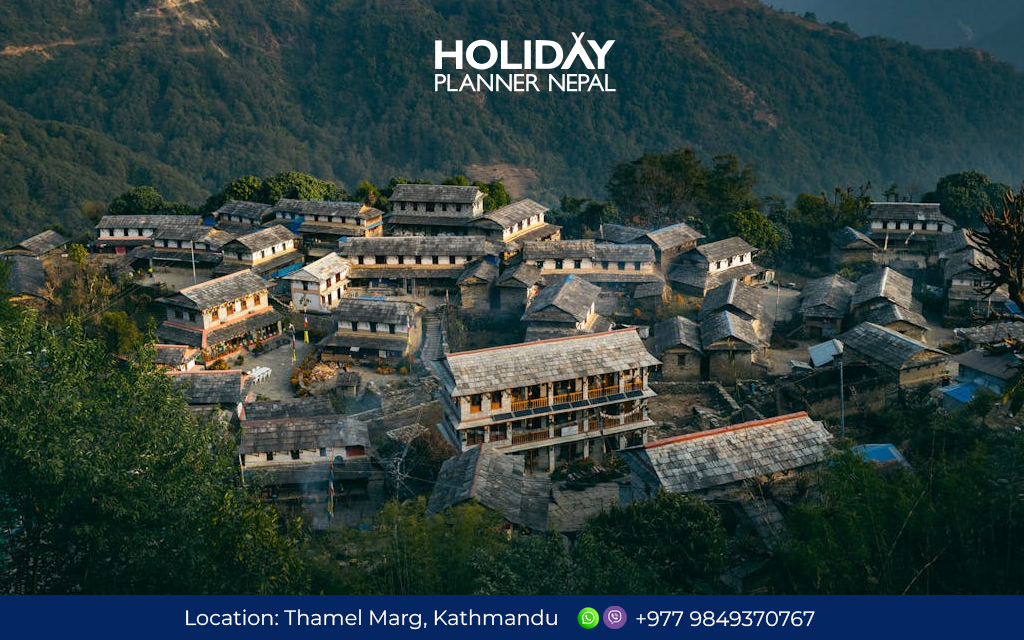
Ghandruk Village is a beautiful Gurung settlement in Nepal's Annapurna area. The Gurung people have a long history of culture and tradition that shapes daily life in Ghandruk. Some characteristics of Ghandruk Village's rich cultural heritage include the following:
- Gurung people are one of the major ethnic groups of Ghandruk who have their own language, customs, and history. Learn anything about the Gurung way of life is easy by visiting Ghandruk.
- Most males in the Gurung community wear the traditional garb known as "Gurung dress," which consists of a robe (kachhad) that ends at the knee and a waistcoat. Beaded necklaces and earrings are just some of the colorful accessories that women wear.
- Gurung culture is deeply rooted in rituals, ceremonies, and the arts. Traditional dances such as the Ghatu (performed at festivals) and the Sorathi (performed at harvest time) may be performed for you to watch.
- Gurung Museum is located at Ghandruk Village, and it offers information about the history, culture, and way of life of the Gurung people. It's a wonderful museum that sheds light on their history.
- In Ghandruk, the majority of Gurungs follow Buddhism and people are Animistic by nature and practice Shaminism and have faith in it. The entire town is decorated with Buddhist stupas, prayer flags, and monasteries. The most well-known is the Ghandruk Monastery, a major place of worship.
- In addition to Dashain, the most important Hindu festival in Nepal, the Gurung group also celebrates Tihar, a festival honoring animals, and Lhosar, the Tibetan New Year. Traditional rituals, food, and dance are all part of these celebrations.
- Residents of Ghandruk are well-known for their welcoming nature. Visitors are showered with warm hospitality, smiles and the traditional presentation of garlands and tika (a red vermillion mark).
- Traditional style buildings and artifacts can be seen throughout the village of Ghandruk. Stone walls, slate roofs, and ornately carved wooden windows and doors are common.
- After tourism agriculture is the main occupation at Ghandruk. Crops like rice, millet, maize, and potatoes are grown in the terraced fields that surround the settlement. It's possible that you'll get to help out on a farm or at least watch some of the action unfold.
- Traditional Gurung food is rich and satisfying. Try some of the local specialties like dal bhat (rice and lentil soup), momo (dumplings), and gundruk (fermented and dried leafy greens) while you're in Ghandruk.
Trekking to Ghandruk Village provides an opportunity to learn about the local culture. One of the best parts of visiting a new place is getting to know the locals and experiencing their culture firsthand. Keep in mind that you should always get permission before photographing traditional customs or taking part in local ceremonies. This conversation with a local enriches your experience at Ghandruk Village.
Accommodation facilities at Ghandruk
Ghandruk is a beautiful Gurung village in Nepal's Annapurna Region, and its lodging options are largely lodges and guesthouses with teahouses. These inns are ideal for hikers, as they provide simple but pleasant facilities. What to expect from Ghandruk's lodging alternatives is as follows:
Teahouses and lodges
Ghandruk's predominant lodging option is teahouse lodges. They are small businesses owned by families who want to help out travelers.These inns have both private rooms and shared sleeping quarters. While dorms often have shared toilets, private rooms may have their own. Each room has a bed, a mattress, a blanket, and a pillow, and is clean and well-maintained. However, a sleeping bag is recommended, especially in the winter months, for increased warmth and comfort.
Power and battery recharge
Ghandruk has access to electricity, however, supply is unpredictable and outages are common. There may be a fee associated with using the charging outlets in some teahouses.
Internet and Cellular Service
Ghandruk residents have had spotty experiences with both internet and cell service. Don't count on constantly-available Internet facilities while you're here.
Meals
Ghandruk's teahouse hotels have restaurants where trekkers can eat. There will be a wide selection of meals available, from those typically found in Nepal and Tibet to those from throughout the world. Rice and lentil soup, known as dal bhat, is a staple diet food.
The majority of teahouses serve all three meals. The teahouse meal package is popular among trekkers because it includes breakfast and dinner. Lunch and additional snacks can be ordered as needed.
Booking in Advance
Teahouses in Ghandruk, in particular the more famous ones, fill up quickly during peak hiking seasons, thus making a reservation in advance is recommended. Holiday Planner Nepal conforms to hotel booking for your comfort.
Sanitation and Personal Hygiene
Cleanliness in Ghandruk's teahouse lodges is usually rather good. Toilet paper and other bathroom necessities aren't always supplied, so it's smart to bring your own.
Staying in a Ghandruk teahouse is a great way to get a feel for genuine mountain life. A sleeping bag, headlamp, and basic toiletries are all things you should bring with you to every teahouse because conditions might vary widely from one to the next.
Scenes and Views:
Annapurna South and Machapuchare may be seen from several of the teahouses in Ghandruk. Pick a hotel that offers the sort of vistas you're hoping for.
Staying in a Ghandruk teahouse is a great way to get a feel for genuine mountain life. A sleeping bag, headlamp, and basic toiletries are all things you should bring with you to every teahouse because conditions might vary widely from one to the next.
Outline Itinerary
Day 1: Drive to Phedi (30min) and trek to Tolka (1810m/5938.3 ft.) 4-5 hrs walk
Day 2: Trek to Ghandruk (1970m/6464 ft.) 4-5 hrs walk
Day 3: Trek to Nayapul-Pokhara (4-5 hrs walk and 2 hrs drive)

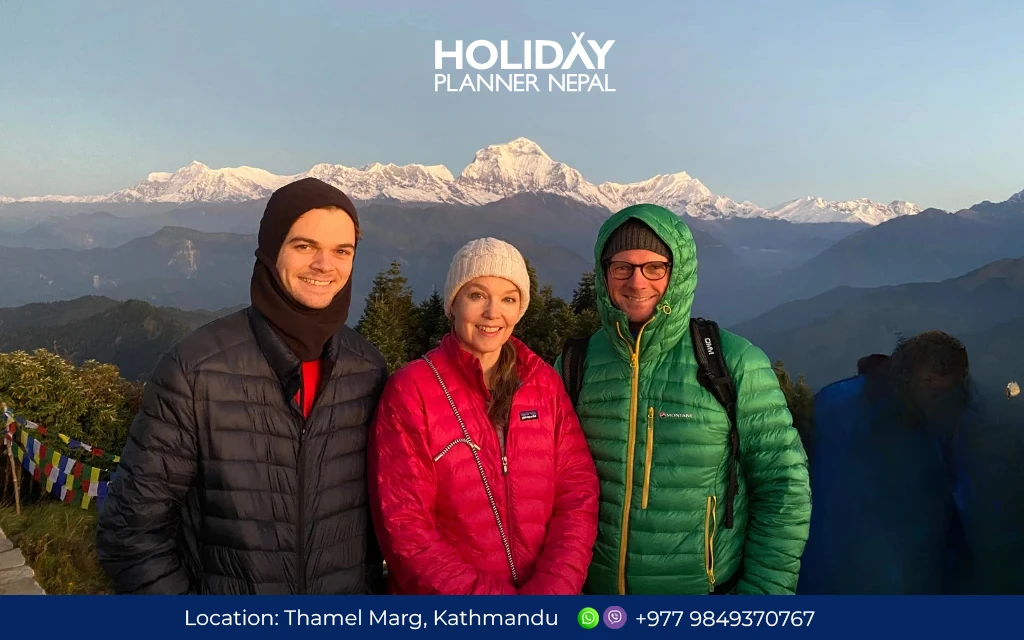
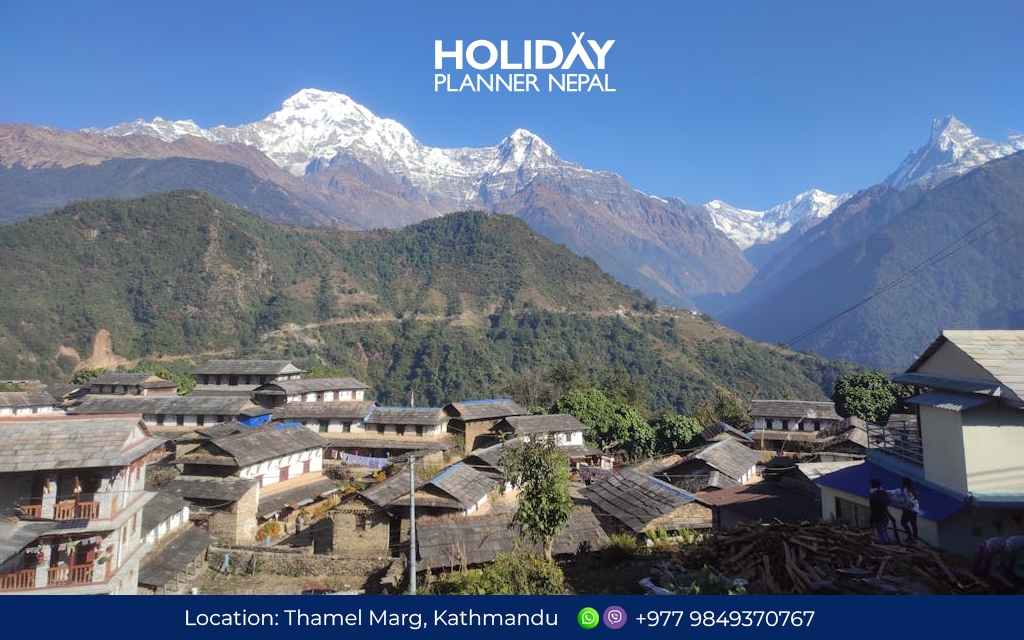
 General
General Upper Body
Upper Body Torso
Torso Lower Body
Lower Body Hands
Hands Feet
Feet Undergarments and Inner Wears
Undergarments and Inner Wears First Aid Kits and Medications
First Aid Kits and Medications Other Essentials
Other Essentials